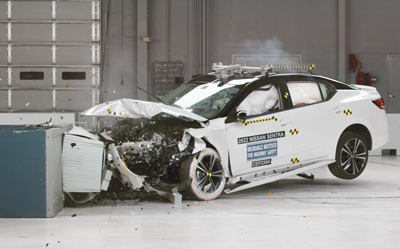Most small cars don’t provide good protection for rear-seat passengers, the latest crash test ratings from the Insurance Institute for Highway Safety show.
“These results highlight one of the key reasons that we updated our moderate overlap front crash test,” said IIHS President David Harkey. “In all the small cars we tested, the rear dummy ‘submarined’ under the seat belt, causing the lap belt to ride up onto the abdomen and increasing the risk of internal injuries.”
None of the five small cars IIHS tested earns a good rating. The Honda Civic sedan and Toyota Corolla sedan are rated acceptable. The Kia Forte, Nissan Sentra and Subaru Crosstrek are rated poor.
IIHS launched the updated moderate overlap front test last year after research showed that in newer vehicles the risk of a fatal injury is now higher for belted occupants in the rear than for those in front. This is not because the rear seat has become less safe. Rather, the front seat has become safer because of improved airbags and advanced seat belts that are rarely available in back. Even with these developments, the back seat remains the safest place for young children, who can be injured by an inflating front airbag.
To encourage manufacturers to improve rear-seat protection, the updated test adds a dummy in the back seat behind the driver. The driver dummy is the size of an average adult man. The rear dummy represents a small woman or 12-year-old child. IIHS researchers also developed new metrics that focus on the injuries most frequently seen in back-seat passengers.
For a vehicle to earn a good rating, there can’t be an excessive risk of injury to the head, neck, chest, abdomen or thigh, as recorded by the second-row dummy. The dummy should remain correctly positioned during the crash without sliding forward beneath the lap belt, and the head should remain a safe distance from the front seatback and the rest of the vehicle interior. A pressure sensor on the rear dummy’s torso is used to check whether the shoulder belt is too high, which can make the restraint system less effective.
As in the original test, the structure of the occupant compartment must maintain adequate survival space for the driver, and measurements taken from the driver dummy shouldn’t show an excessive risk of injuries.
All five small cars provided good protection in the front seat. However, measurements indicated a slightly higher risk of head or neck injuries to the driver in the Sentra. For the rear seating positions, it was a different story.
In all five vehicles, the rear dummy submarined beneath the seat belt, causing the lap belt to slide from the hip bones onto the abdomen, where it can cause internal injuries.
In the three poor-rated vehicles, measurements taken from the rear dummy also showed a moderate or high risk of head, neck or chest injuries.
Apart from submarining by the rear dummy, the acceptable-rated Civic and Corolla mostly provided adequate protection in the back seat. In the Corolla, the rear dummy’s head also approached the front seatback, which increases the risk of head injuries.
Source: IIHS










